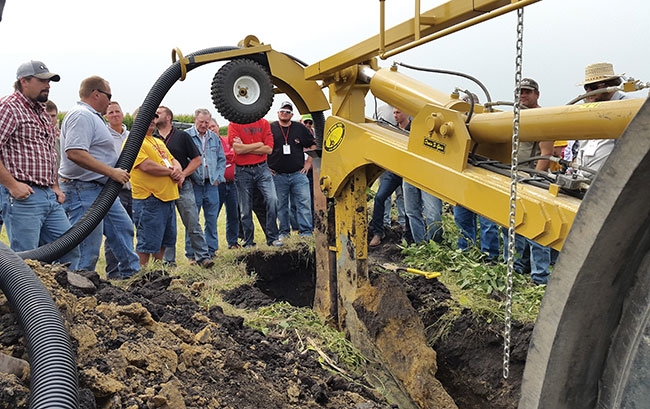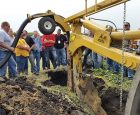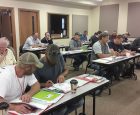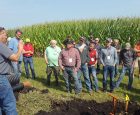
Features
Contractor at Work
Iowa Drainage School 2018
Staying up to date with subsurface drainage
October 23, 2018 By Dr. Kapil Arora
 A photo from Iowa Drainage School 2016. The school has been offered every year since 2007. Staying up to date with subsurface drainage.
A photo from Iowa Drainage School 2016. The school has been offered every year since 2007. Staying up to date with subsurface drainage.Continuing education is part of any career – including a drainage contractor’s. Agricultural drainage systems are complex. Contractors must pay attention to local laws, soil types, slope, environmental considerations and size, depth and spacing of tile.
Iowa State University, in collaboration with the University of Missouri and Iowa Soybean Association, hosted a farmland subsurface drainage school in August 2018 at the Borlaug Learning Center in Nashua, IA. The three-day Iowa Drainage School included classroom lectures, discussions, team problem solving and field exercises, and provided a unique educational opportunity for attendees, which included contractors, farmland owners, drainage consulting engineers, drainage equipment manufacturers, county officials, and technical service providers from eight different states. The school focused on the fundamentals of drainage design including understanding soils, obtaining an accurate survey, drainage pipe size and spacing, controlled drainage and water table management, sub-irrigation, legal considerations, different installation techniques and equipment.
Surveying the land
The school started with a morning session to help participants understand soils and their properties influencing water movement. Participants then conducted augur-hole tests to see how quickly water moves laterally within soil. In the afternoon, participants worked in groups to complete a field survey using handheld GPS units and Laser Levels in collaboration with Roger and Brady Kolbet of MidTech Services. Thinking like surveyors, participants learned how to correct common elevation and horizontal location issues, and how to work with contour maps to determine available depths of installation. In the evening, participants observed demonstrations of three different drainage design softwares, GK Technology’s SD Drain, Trimble’s FarmWorks, and Ag Leader’s SMS Advanced, to lay out tile.
Planning it out
Groups worked through problem sets to understand how tile size is influenced by the installation site and learned how to size drainage tile for a specific drainage coefficient. Participants put all the information together to complete a drainage plan for the field that was surveyed on the first day. To conclude the day, Jacob Handsaker (Hands-On-Excavating) and Jim Johnson (Johnson Tile Plow) discussed using GPS and laser levels for tile installation.
Boulders, barriers and runoff concerns
Participants learned how to install tile on contour lines, use control structures and followed a field demonstration of tile installation which wasn’t without its barriers. A big boulder stopped a tile plow dead in its tracks during the installation. The demonstration showed participants how to work with big boulders and after, following the demonstration, Mark Paca (Midwest Pipe Supply) led a discussion on the various issues faced during tile installation and simple strategies to achieve a quality installation.
In addition to learning how to install tile, the school participants learned the potential environmental effects of drainage such as nutrient transport. Participants learned how to reduce nitrogen concentrations in drainage water with wetlands, woodchip bioreactors, conservation drainage, saturated buffers, shallow drainage, drainage water recycling and
cover crops.
Ray Slach shared his experience with excavation safety and the need to call “811-One Call” to locate all the buried utilities when planning and installing drain tile. Don Etler (Bolton and Menk Engineers) spoke about drainage laws and how they relate to drainage district functions.
The school concluded with each group presenting their drainage plans. Each team discussed different features of their design and how these features addressed functionality, flexibility and performance.
Print this page


